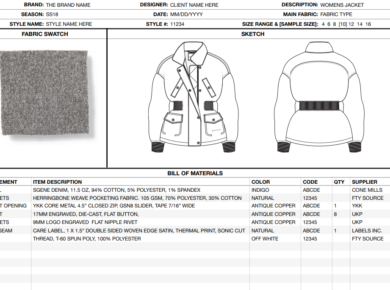In today’s fast-paced fashion industry, transparency is crucial for making informed decisions and establishing trust with sourcing suppliers. With increasing pressure from consumers and government policies alike calling for more transparency and sustainability, being well-informed and transparent in supplier and consumer relationships can be the key to success. In this article, we’ll delve into the importance of transparency and how it contributes to more ethical and environmentally-friendly practices.
Building Stronger Relationships
Transparency between brands and suppliers leads to stronger long-term relationships and fosters trust and collaboration. When suppliers openly share their practices and performance data, it demonstrates their commitment to ethical and sustainable practices. This openness allows brands to make better-informed decisions and work closely with suppliers to address any concerns, ultimately leading to a more efficient and effective supply chain.
Transparent communication between fashion brands and suppliers strengthens relationships, fostering collaboration and driving continuous improvements in the industry.
Ensuring Ethical Labour Practices
Transparency in fashion supplier sourcing allows brands to verify that their suppliers adhere to ethical labour practices. For instance, knowing the working conditions, wages, and employee benefits can help identify potential issues such as forced labour, child labour, or exploitation. By having access to this information, brands can make informed decisions and choose suppliers with a track record of treating their workers fairly.
Transparency enables fashion brands to ensure that their suppliers are upholding ethical labour practices, leading to a more responsible and sustainable fashion industry.
Assessing Environmental Impact
Having detailed information on suppliers’ environmental practices and sustainability policies allows brands to evaluate the environmental impact of their supply chain. Given that textile production accounts for 10% of global carbon emissions there are several challenges needed to be tackled to successfully lower these figures. Historically suppliers had been seen as purely a competitive advantage and therefore keeping information tight-lipped protected a brand and kept them ahead of the competition. In recent years there has been a shift in perception where companies are weighing up the value created in sharing this information compared to keeping it under wraps. There is a common goal among brands and retailers and from our experience, there is more to gain in sharing information than keeping it private.
Brands need to have clear information about suppliers’ environmental impact which includes data on energy consumption, waste management, and material sourcing. By being transparent in these areas, brands can select suppliers with a lower environmental footprint and better align with their own sustainability goals.
Transparent supplier sourcing empowers fashion brands to assess and reduce the environmental impact of their products, contributing to a greener industry.
The importance of ethical and environmental practices
Financial losses and damaged reputation due to boycotts and negative publicity
When a company is discovered to have unethical or environmentally harmful practices in their supply chain, it can lead to boycotts from consumers and negative publicity in the media. This can result in significant financial losses, loss of customers, and a damaged reputation that can be difficult to repair.
Compromised product quality and increased supply chain risks
Companies with poor ethical and environmental practices often rely on suppliers that cut corners, which can lead to compromised product quality and increased supply chain risks. These issues can result in more frequent product recalls, increased costs associated with addressing quality issues, and a potential loss of flexibility in responding to market changes.
One way to improve product quality is the use of nearshoring, whereby team members are able to visit factories on a regular basis due to geographical location be closer to companies HQ. Also language barriers are less prevalent which can be a factor in quality issues.
Challenges faced by sourcing experts in trying to obtain supplier information
Sourcing experts can face several challenges when trying to obtain supplier information. One of the main challenges is the lack of transparency in the supply chain. Many suppliers are not willing to disclose information about their sourcing practices, including where they source their materials and how they treat their workers. This lack of transparency can make it difficult for sourcing experts to assess the ethical and environmental impact of their suppliers.
This challenge contributes to the issue that only 12% of fashion companies publish a supplier list.
Another problem is the complexity of the supply chain. Many fashion brands work with multiple suppliers, each of which may have their own suppliers and subcontractors. This makes it difficult to trace the origin of materials and ensure that all suppliers are meeting ethical and environmental standards. Additionally, many suppliers operate in countries with weak labour and environmental regulations, making it difficult to ensure that they are operating ethically.
However, to overcome these challenges, sourcing experts can take several steps. One approach is to work with suppliers who are committed to transparency and ethical practices. This can involve conducting audits of suppliers to ensure that they are meeting ethical and environmental standards, as well as working with suppliers to develop plans for improving their practices over time. Another way to ensure these standards is through the use of technology. Sourcing experts can use various software programs to track the supply chain and ensure that suppliers are meeting ethical and environmental standards. Finally, sourcing experts can work with industry groups and NGOs to develop standards and best practices for ethical and sustainable sourcing.
Obtaining supplier information can be challenging for sourcing experts in the fashion industry. However, by working with suppliers who are committed to transparency and ethical practices, using technology to track the supply chain, and collaborating with industry groups and NGOs sourcing experts can overcome these challenges and ensure their companies are sourcing materials and products ethically and sustainably.
The benefits of transparency for the fashion industry
By knowing exactly where and how products are being produced, a brand can identify potential risks and take steps to mitigate them. This can include addressing issues such as child labour, unsafe working conditions, and environmental damage. Having transparency between brands and suppliers allows brands to highlight and manage these risks faster, avoiding costly legal battles and damage to their reputations.
Transparency is also important for compliance with legislation and regulations. Many countries have laws in place to protect workers and the environment that fashion brands must comply with to avoid legal penalties. By being transparent about their supplier sourcing, a brand can ensure that they are meeting these legal requirements and avoid any issues.
Below are just some of the new legislations coming into force:
Transparency in Supply Chains Act (TSCA) in the United States requires companies with over $100 million in global sales to disclose their efforts to eradicate slavery and human trafficking from their direct supply chains. Brands must provide a statement on their website that outlines their efforts to eradicate slavery and human trafficking from their supply chains.
UK Modern Slavery Act requires companies with a turnover of over £36 million to produce an annual statement outlining the steps they have taken to ensure that slavery and human trafficking are not taking place in their supply chains. Brands must provide a statement on their website that outlines their efforts to eradicate slavery and human trafficking from their supply chains.
France’s Duty of Vigilance Law requires companies with over 5,000 employees in France, or over 10,000 employees worldwide, to establish and implement a vigilance plan to identify and prevent human rights abuses and environmental damage throughout their supply chains. Brands must establish and implement a vigilance plan that identifies and prevents human rights abuses and environmental damage throughout their supply chains.
California Transparency in Supply Chains Act requires companies with over $100 million in global sales to disclose their efforts to eradicate slavery and human trafficking from their direct supply chains. Brands must provide a statement on their website that outlines their efforts to eradicate slavery and human trafficking from their supply chains.
Australian Modern Slavery Act requires companies with a turnover of over $100 million to produce an annual statement outlining the steps they have taken to ensure that slavery and human trafficking are not taking place in their supply chains. Brands must provide a statement on their website that outlines their efforts to eradicate slavery and human trafficking from their supply chains.
The German Supply Chain Act requires companies with more than 3,000 employees to establish a due diligence system for human rights and environmental risks in their supply chains3.
The Netherlands’ Child Labor Due Diligence Law requires companies to identify, prevent and address child labour in their supply chains4.
Transparency is crucial nowadays for a fashion brand to gain the trust of its customers. Providing information about its suppliers shows consumers that the brand is committed to ethical and sustainable practices. This creates increased customer loyalty and positive word-of-mouth marketing, ultimately resulting in higher sales and revenue. By showing the depths of its commitments to sustainable practices, brands can also identify areas for improvement in the supply chain, such as unethical labour practices.
Transparency additionally allows fashion brands to manage their reputation. If a brand is found to be associated with unethical practices, it can damage its reputation and lead to a loss of customers. By being transparent about its supplier sourcing, a brand can avoid negative publicity and maintain a positive image in the eyes of its customers.






